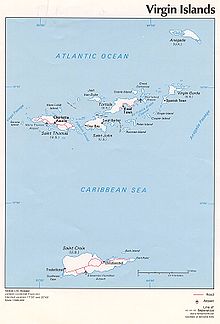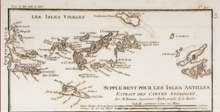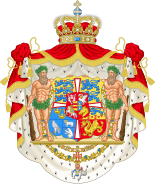Virgin Islands
Satellite image, October 2008 | |
 | |
| Geography | |
|---|---|
| Location | Caribbean Sea, Atlantic Ocean |
| Coordinates | 18°12′N 64°48′W / 18.2°N 64.8°W |
| Archipelago | Leeward Islands |
| Insular area | United States Virgin Islands |
| Insular area | Puerto Rico |
| Overseas territory | British Virgin Islands |
| Demographics | |
| Population | 150.000 (estimation) (2022) |
| Languages | English Virgin Islands Creole Spanish |
| Ethnic groups | Afro-Caribbean White-Caribbean Hispanic-Caribbean Asian-Caribbean Indo-Caribbean |
The Virgin Islands (Spanish: Islas Vírgenes) are an archipelago between the North Atlantic Ocean and northeastern Caribbean Sea, geographically forming part of the Leeward Islands of the Lesser Antilles in the Caribbean islands or West Indies.
Geologically separated from the Lesser Antilles by the Anegada Passage and from the Greater Antilles by the Mona passage, all the islands except for Saint Croix lie on the same carbonate platform and insular shelf, known as the Puerto Rico Bank, and same tectonic plate, known as the Puerto Rico–Virgin Islands microplate.
Politically, the islands fall into three jurisdictions: the easternmost British overseas territory of the Virgin Islands, informally referred to as the British Virgin Islands, the central unincorporated American territory of the Virgin Islands of the United States, commonly known as the U.S. Virgin Islands, and the westernmost island-municipalities of the unincorporated American territory of Puerto Rico, officially named Vieques and Culebra but generally called the Spanish Virgin Islands or Puerto Rican Virgin Islands.

Etymology
[edit]

Christopher Columbus named the islands after Saint Ursula and the 11,000 Virgins (Spanish: Santa Úrsula y las Once Mil Vírgenes), shortened to the Virgins (las Vírgenes). The official name of the British territory is the Virgin Islands, and the official name of the U.S. territory is the Virgin Islands of the United States. In practice, the two island groups are almost universally referred to as the British Virgin Islands and the U.S. Virgin Islands.
History
[edit]The Virgin Islands were originally inhabited by the Arawak and Carib, many of whom are thought to have perished during the colonial period due to enslavement, foreign disease, and war brought about by European colonists.[1]
European colonists later settled here and established sugar plantations and at least one tobacco plantation, and bought slaves from Africa. The descendants of the enslaved people remain the bulk of the population, sharing a common African-Caribbean heritage with the rest of the English-speaking Caribbean. Instead, African slaves were brought to the islands to work on sugarcane and indigo plantations. There are now no sugar plantations, but the descendants of slaves remain and make up the majority of the West Indian culture of the island's population, as well as the English-speaking population of other islands in the Caribbean.
Like mainland Puerto Rico, the Virgin Islands that belonged to Spain were ceded to the United States in 1898. The United States took possession of the islands after the signing of the armistice that put an end to military operations in the Spanish–American War.
A 1916 treaty between the United States and Denmark (not ratified by the United States until 1917) resulted in Denmark selling the Danish Virgin Islands to the United States for $25 million in gold.
Historical affiliations
[edit]The Virgin Islands have been under the sovereignty of several nations and groups throughout history. Below is a table which represents the affiliation of the various islands:
* Largely under control of pirates.
** Coexisting claim.
*** Leased/shared territory.
Demographics
[edit]The total population of the Virgin Islands is 147,778: 104,901 in the U.S. Virgin Islands, 31,758 in the British, and 11,119 in the Spanish. Roughly three-quarters of islanders are black in the British and U.S. Virgin Islands, while the majority of inhabitants in Culebra and Vieques are Puerto Rican of European descent, with a significant Afro-Puerto Rican community. The main languages are English and Virgin Islands Creole in the U.S. and British Virgin Islands, and Spanish in the Puerto Rican territory. St. Thomas is the most populous island, with St. Croix close behind (51,634 and 50,601, respectively).
| Name | Sovereign State | Subdivisions | Area (km2) |
Population (2005 est.) |
Population density (per km2) |
Capital |
|---|---|---|---|---|---|---|
| British Virgin Islands | United Kingdom | Districts | 153.0 | 31,758 | 207.6 | Road Town |
| Spanish Virgin Islands (Puerto Rico) | United States | Barrios | 165.1 | 11,119 | 67.3 | San Juan, PR |
| United States Virgin Islands | United States | Districts | 346.4 | 104,901 | 302.8 | Charlotte Amalie |
| Total | 664.5 | 147,778 | 222.4 |
Traffic control
[edit]Motor vehicles are driven on the left-hand side of the road in both the British and the U.S. Virgin Islands, although the steering wheels on most cars are located on the left side (as is the norm for drive-on-the-right localities). In the Spanish Virgin Islands, vehicles are driven on the right-hand side of the road.
See also
[edit]- Culture of the Virgin Islands
- Danish Virgin Islands
- Dutch Virgin Islands
- Music of the Virgin Islands
- Virgin Islands Creole
- Virgin Islands patch reefs
Citations
[edit]- ^ Pereña, Luciano (1992). Genocidio en América. Madrid: Editorial MAPFRE. p. 351. ISBN 84-7100-453-4.
General sources
[edit]- Colin Thomas, J.; Allard, William Albert; Wolinsky, Cary (February 1981). "Paradise Comes of Age: The U.S. Virgin Islands". National Geographic. Vol. 159, no. 2. pp. 225–243.
External links
[edit]Virgin Islands.
- BVI.gov: British Virgin Islands government website
- U.S. Office of Insular Affairs: United States Virgin Islands government website
- Digital Library of the Caribbean: University of the Virgin Islands information
- U.S. Virgin Islands: Resource Guide, from the Library of Congress
- . Encyclopædia Britannica. Vol. XXIV (9th ed.). 1888.



